offline
- dragon986
- Legendarni građanin

- Pridružio: 02 Jun 2013
- Poruke: 3803
|
Napisano: 16 Jan 2022 14:34
Odlična serija članaka na top.war-u o uniformama pa pošto nisam našao relevantnu temu postavio sam kao novu:
History of uniforms. Beginning of red uniforms
History of uniforms. Today we continue our story about the uniforms of servicemen of different times and peoples, and today we will talk about uniforms ... the British, or rather its very beginning.
And the beginning took place between 1640 and 1660 or the era of the English bourgeois revolution. Then the striking force of the army of parliament was the Yeoman cavalry of Cromwell, the discipline of which was based on the voluntary submission of soldiers to the adopted charter. Any problems, including political ones, were openly discussed in the army, its soldiers were much more conscious and disciplined than the soldiers of the Royal Army. Since for the most part the soldiers of the "new model" army were Puritans, they dressed in Puritan fashion, plus practical expediency.
That's why the riders wore a leather (sedeede) prick, on top of which a cuirass and a round hat were worn, replaced by a helmet in a combat atmosphere. Well, the infantrymen - pikemen, also wore cuirasses with loincloths and Morion or cabasset helmets, and musketeers "flaunted" in cheap caftans and the same pants made of gray unble cloth. Officers were distinguished by scarves, in addition, they also had an halberd in the infantry.
So at first and for a very long time, the English army was mostly dressed in yellow skin and gray cloth! However, in 1660, the army, and primarily the Royal Guards of King Charles II, looked very different. Something, and they didn't regret the red cloth for the guards!
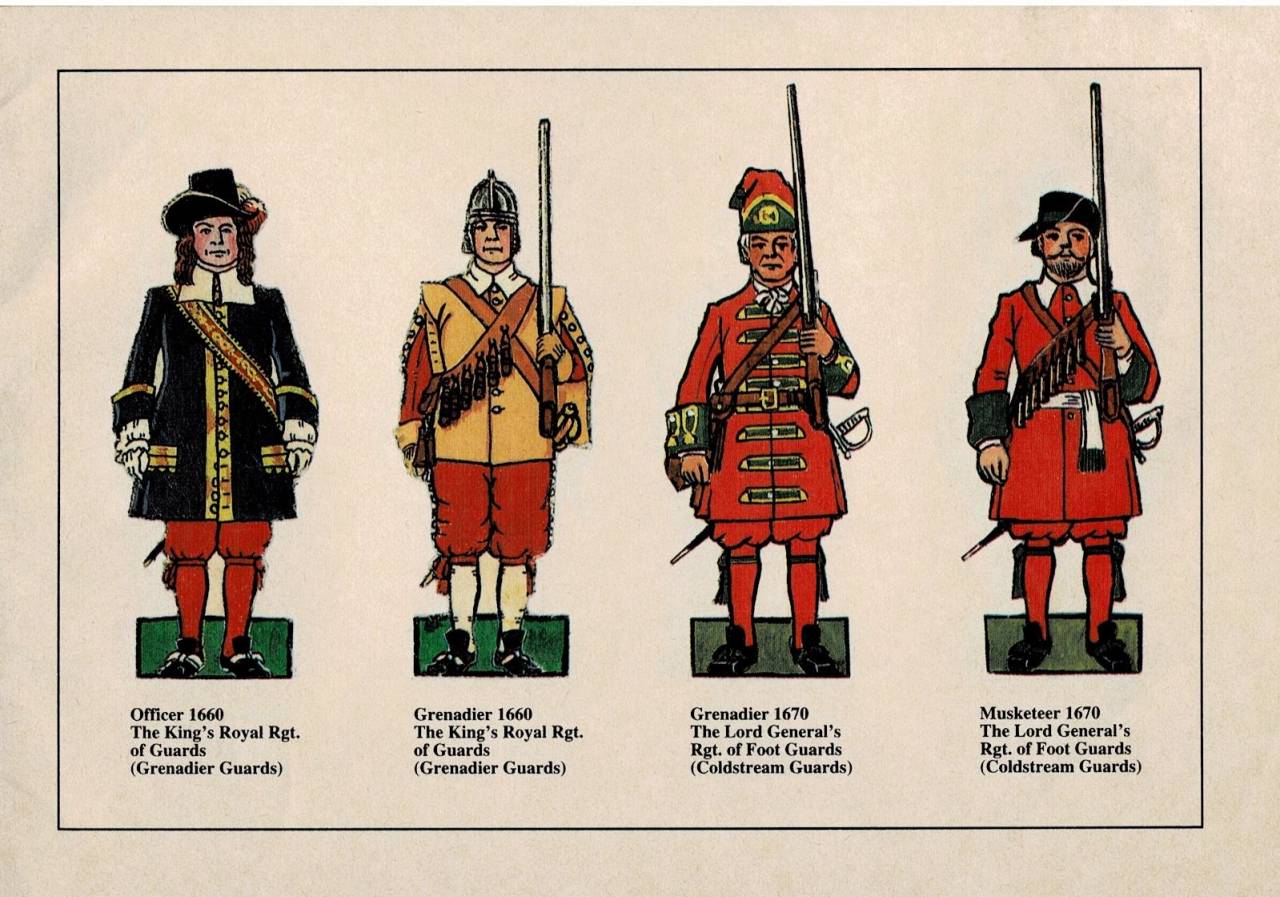
But it should be emphasized that this is how the guard dressed. Even at the end of the XVII century, the bulk of the line infantry wore gray cloth caftans, and could only dream of a "red uniform"!
Red color in the English army also became common because the patron saint of the country and its troops was St. George, whose emblem was a simple red cross on a white background. In addition, good dyes that gave red color were already obtained from bag and thorns, marena and some other plants. And later, having pushed the Dutch, Portuguese and Spaniards on the seas, the British gained access to carmine - a high-quality red dye of animal origin, which was obtained from female moshenili - insects parasitizing plants.
However, not all shelves at that time went in gray and red. There were also shelves dressed in blue uniforms.
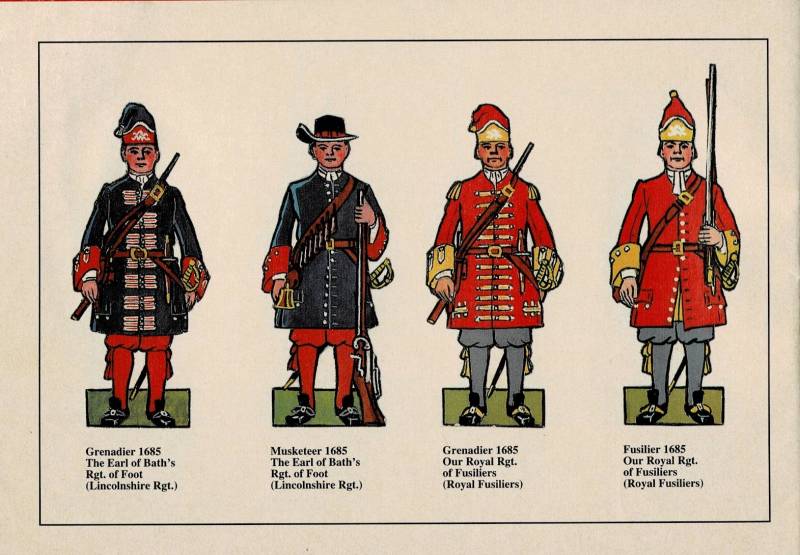
And these are completely "red" soldiers and officers: a sapper regiment of the Royal Fusiliers, a colonel of the 5th Regiment of Northumberland Fusilers of 1689, a private of the 1st Guards Infantry Grenadiers Regiment of 1705 and an officer of the same regiment in uniform in 1745. The last two, as you can see, hats with a field bent in one direction have already turned into triangulars! The uniform caftan itself, by the way, has lapels on it, now it has become fashionable to fasten only partially or not to fasten at all so that you can see camisole under it. He almost completely repeated the style of caftan, but usually had no sleeves and could be made of fabric of a different color from a uniform. Culottes - short knee-length pants did not go out of fashion, but instead of stockings with garters, they now began to wear linen leggings with an overlap on their shoes. The phaldy of the uniform caftan began to be twisted, fastening the lapels with a button.
It should be noted that just by 1745, the financial well-being of Great Britain had already increased so much that ordinary army regiments began to receive "red uniforms".
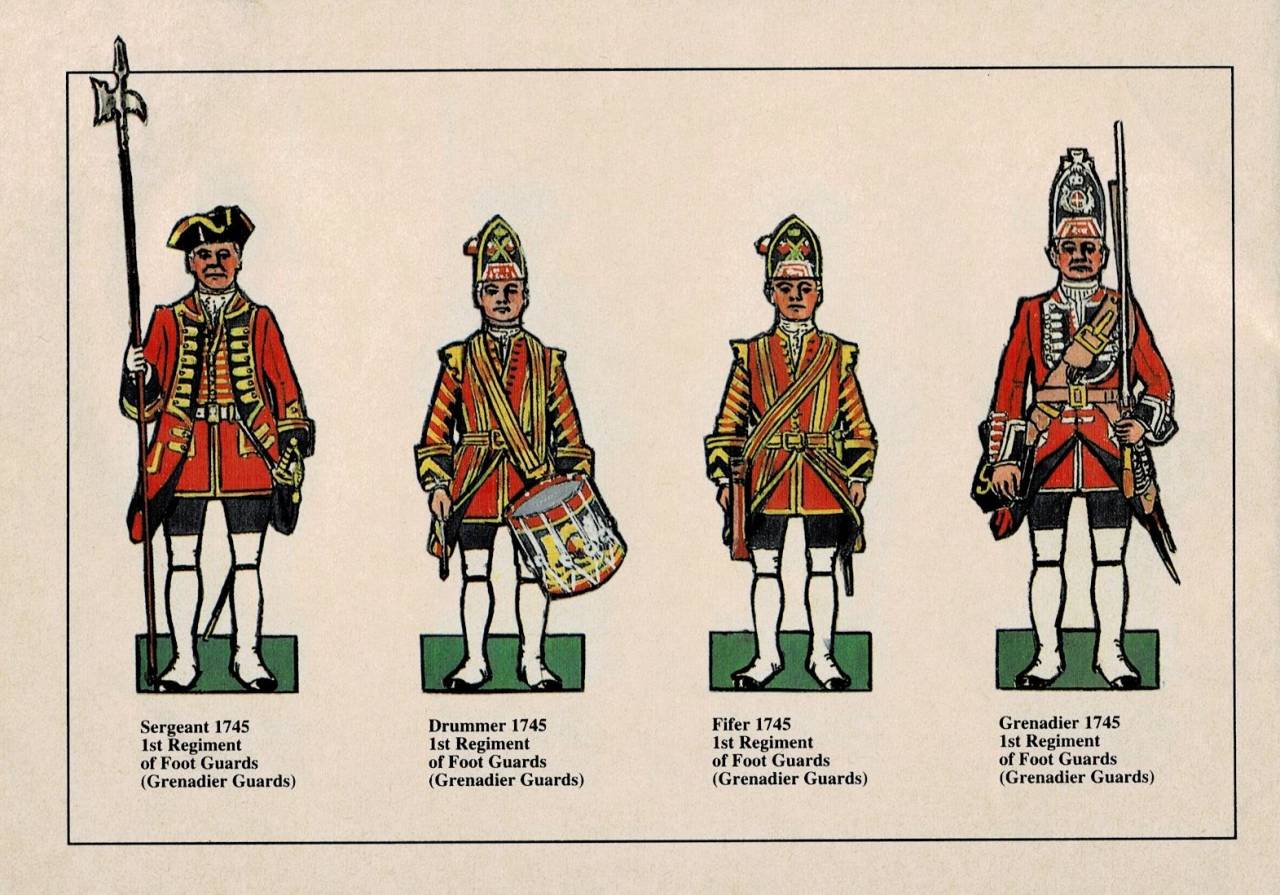
And then there is an officer and Private of the 30th Regiment of East Yorkshire in 1745, Private Royal Irish Guard (18th Infantry Regiment) and grenadier of the 36th Worcester Infantry Regiment. As you can see, the difference in the design of uniforms is not so great. Interestingly, the British had embroidered, not metal headplate, grenadier's grenadiers. And the embroidery on them was very beautiful, but... the British clearly regretted the metal on them. And also from the experience of the war, their cartridge frog was moved to their stomach! Drawings by Arthur Bowling from the album: British infantry regiments 1660-1914. А.Х. Боулинг. L.: Argus Pub. 1992
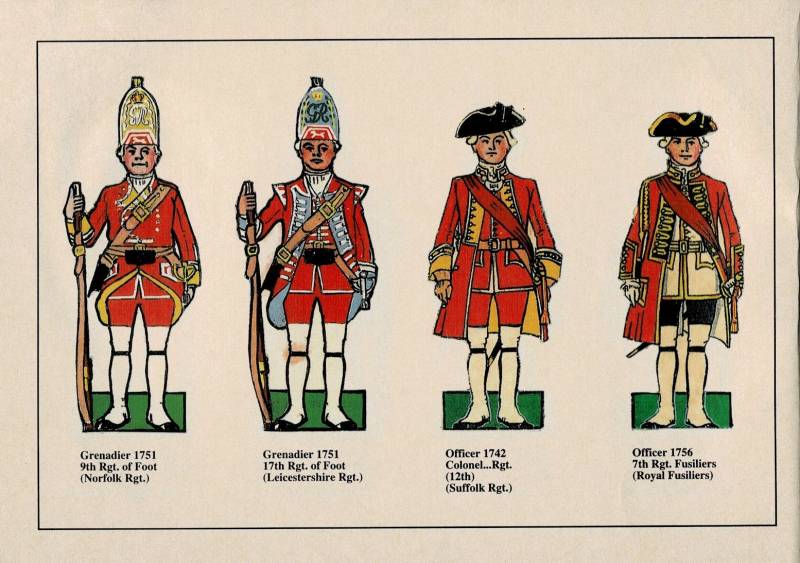
1768 was a turning point for British military fashion in some way. Red pants disappeared in the infantry regiments. They were replaced with white ones. Camisoles have become white. The uniforms became all the same in cut, and the shelves differed in the colors of lapels and slags. Grenadiers received fur grenadier hats, although they were not very large in size. Hethrows or stem cuffs, as they were then called, have become black. Belts for ammunition began to whiten. Before that, they were made of yellow buffalo leather.
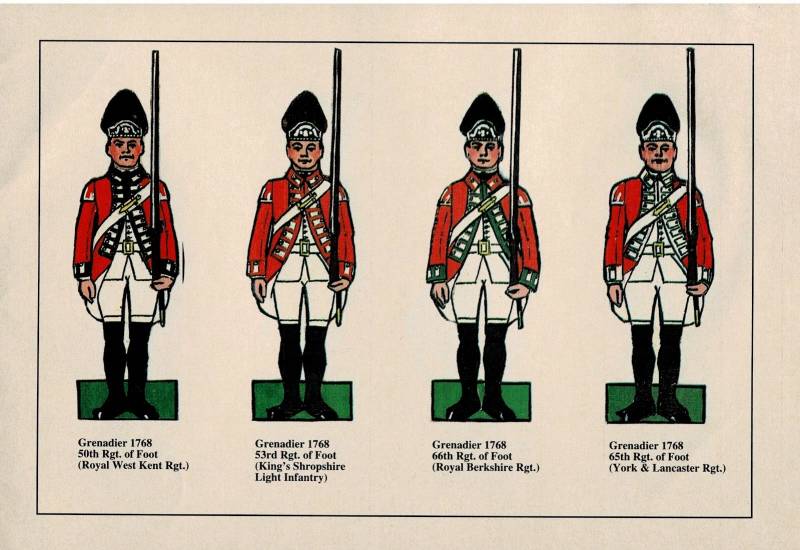
A new change in the clothes of British soldiers took place in 1790. Camzoles worn under uniform were replaced with white or fawn vests. The uniform has acquired a high stand-up gate that almost rests on its ears. Officers received boots with lapels, the stem cuffs became much shorter. Grenadiers have tall fur hats with small sultans.
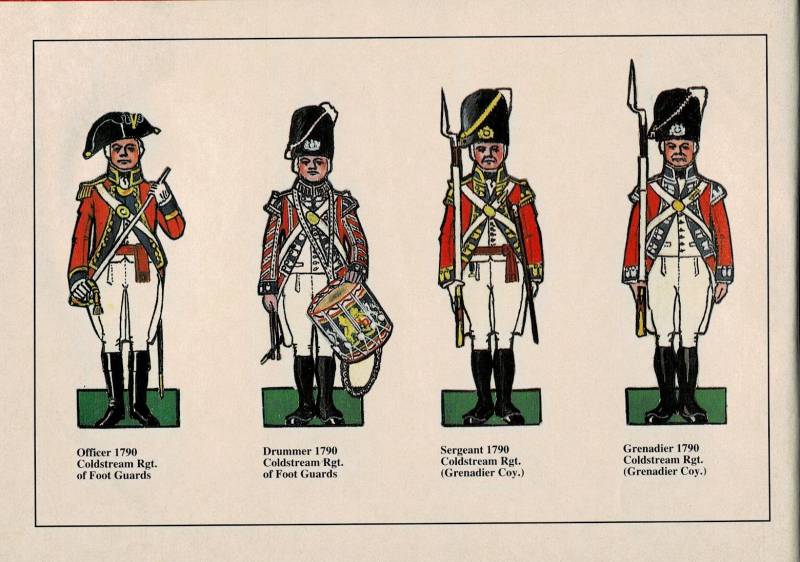
However, not all pantaloons and vests were white. In some shelves, they were dark yellow, "buffalo leather colors", as they said in England, which is why the shelves that had such a color in uniforms were nicknamed "The Buffs" (which can literally be translated as "Buivoles", "Buffs" or "Fog-leather"). In particular, the Royal East Kent Regiment had this color.
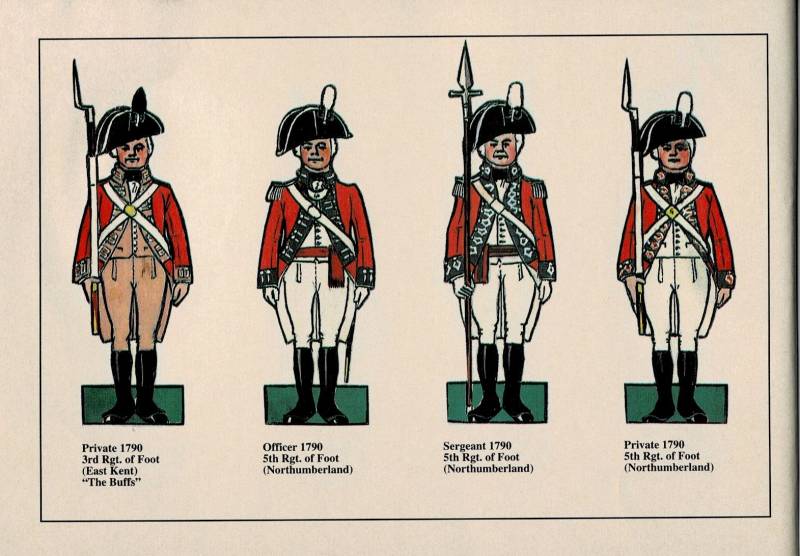
Please note that the fashion for hats has also changed. The hat with three curved corners was replaced by a hat with two double-angle curved upwards. And it was considered chic to wear it somewhat obliquely...
Hairstyles... all this time since 1745 has been a time of buxles and wigs, which were quite another hat. And how else would you order to fight lashes? A head shaved naked or with a very short haircut is easy to put in order. It's enough to hold the wig over the fire and all the sies in it will come to an end, but how to deal with them in your own long hair? That's what they were abandoned in the army!
P.S. Please note - in fact, we have ready-made drawings for so-called flat-printed soldiers. There is also such a direction in their production and collection. But there will be a separate material about it...
To be continued...
Dopuna: 16 Jan 2022 14:35
Evo ga i link
https://topwar.ru/190791-istorija-uniformy-nachalo.....chalo.html
|

